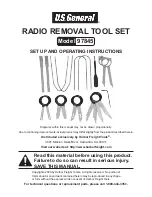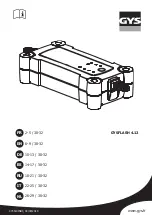
The PAD indicator light should not be illuminated when
an adult passenger is properly seated in the front pas-
senger seat. The driver and adult passenger should
verify that the PAD Indicator Light is not illuminated
when an adult is riding in the front passenger seat. If an
adult is not seated properly, the Passenger Advanced
Front Air Bag may deactivate and the PAD Indicator
Light will be illuminated.
The PAD Indicator Light should be illuminated and the
Passenger Advanced Front Air Bag should be deactivated
for most properly seated and restrained children in the
passenger seat and for most properly installed child
restraint systems. However, under certain conditions, even
with a properly installed child restraint system, the PAD
Indicator Light may not be illuminated, even though the
Passenger Advanced Front Air Bag is deactivated. This can
occur if the child restraint is lighter than the lightest
weight necessary to illuminate the PAD Indicator Light.
NEVER
assume the Passenger Advanced Front Air Bag
is deactivated unless the PAD Indicator Light is illumi-
nated with the words “PASSENGER AIR BAG OFF.”
NOTE:
If the seat belt is buckled for an empty seat, the PAD
Indicator Light will illuminate.
If The PAD Indicator Light Is Illuminated For An Adult
Passenger:
If an adult passenger is seated in the front passenger seat
and the PAD Indicator Light is illuminated, the passenger
may be sitting improperly. Follow the steps below to allow
the OCS to detect the adult passenger’s seated weight to
activate the Passenger Advanced Front Air Bag:
1. Turn off the vehicle and have the adult passenger
step out of the vehicle.
2. Remove any extra materials from the passenger
seat, such as cushions, pads, seat covers, seat mas-
sagers, blankets, extra clothing, etc.
3. Place the seatback in the full upright position.
4. Have the adult passenger sit in the center of the
seat, with the passenger’s feet comfortably on or
near the floor, and with their back against the
seatback.
5. Restart the vehicle and have the passenger remain
in this seated position for two to three minutes after
restarting the vehicle.
WARNING!
•
If the PAD Indicator Light remains illuminated for
an adult passenger, have an authorized dealer
service the air bag system immediately. Failure to
do so may cause serious injury or death. If the PAD
Indicator Light is illuminated with the words "PAS-
SENGER AIR BAG OFF," the Passenger Advanced
Front Air Bag will not deploy in the event of a
collision.
•
Never place a rear-facing child restraint in front of
an air bag. A deploying passenger front air bag can
cause death or serious injury to a child 12 years or
younger, including a child in a rear-facing child
restraint.
•
Never install a rear-facing child restraint in the
front seat of a vehicle. Only use a rear-facing child
restraint in the rear seat. If the vehicle does not
have a rear seat, do not transport a rear-facing
child restraint in that vehicle.
(Continued)
WARNING!
•
Children 12 years or younger should always ride
buckled up in the rear seat of a vehicle with a rear
seat.
Lighter Weight Passengers (Including Small Adults)
When a lighter weight passenger, including a small
adult, occupies the passenger seat, the Passenger
Advanced Front Air Bag may be deactivated. Therefore,
the Passenger Advanced Front Air Bag may or may not
be activated for a lighter weight passenger, including a
small adult (depending on size) who is seated in the
passenger seat. This does not mean that the OCS is
working improperly.
The driver and passenger must always use the PAD
Indicator Light as a determination of whether the Pas-
senger Advanced Front Air Bag is activated or deacti-
vated. If the PAD Indicator Light is illuminated with the
words “PASSENGER AIR BAG OFF” when an adult is in
the front passenger seat, have the passenger reposi-
tion his or her body in the seat until the PAD Indicator
Light goes out.
If the PAD Indicator Light is illuminated with the words
“PASSENGER AIR BAG OFF” the Passenger Advanced
Front Air Bag will not inflate in the event of a collision.
Do Not Decrease OR Increase The Front Passenger’s
Seated Weight On The Front Passenger Seat
The front passenger’s seated weight must be properly
positioned on the front passenger seat. Failure to do so
may result in serious injury or death. The OCS deter-
mines the most probable classification of the occupant
that it detects. The OCS will detect the front passen-
ger’s decreased or increased seated weight, which may
result in deactivation or activation of the Passenger
Advanced Front Air Bag in a collision. This does not
SAFETY
249
6
5538906_24_JL_OM_EN_USC_t_E1.pdf 249
5/22/2023 9:02:27 AM
















































